‘Stan & Ollie’ celebrates persistence, reinvention
‟Stan & Ollie“ (2018). Cast: John C. Reilly, Steve Coogan, Shirley Henderson, Nina Arianda, Danny Huston, Rufus Jones, Susy Kane, Richard Cant. Director: Jon S. Baird. Screenplay: Jeff Pope. Book: A.J. Marriot, Laurel and Hardy: The British Tours. Web site. Trailer.
It’s hard to keep a good man – or a good team – down. Those who are determined to carry forward with their plans, no matter what they may be, are usually difficult to contain. And, when you add the power of a collaborative effort to the mix, the ability to hold them back may be nearly impossible. So it was for a comedy duo seeking to revive their career in their waning days as seen in the entertaining new biopic, “Stan & Ollie.”
In 1937, Stan Laurel (Steve Coogan) and Oliver Hardy (John C. Reilly) were the biggest comedy duo in the entertainment business. Their films were screened throughout the US and around the world, and virtually no one in Hollywood was bigger than they were. But, in the ensuing years, that all began to change.
Because Laurel and Hardy were under separate contacts with studio chief Hal Roach (Danny Huston), they weren’t operating on a level playing field, a source of frustration and consternation for Laurel individually (he wasn’t getting his due) and for the pair collectively (they didn’t have the creative clout they sought that a joint contract would afford). What’s more, during his contract dispute with Laurel, Roach paired up Hardy with comedian Harry Langdon (Richard Cant) for a film called “Zenobia” (1939), an incident that rubbed Laurel the wrong way. And, even though Laurel and Hardy resumed working thereafter, their career was strained – and waning.
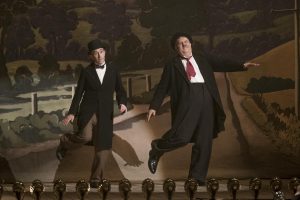
The comedy duo of Stan Laurel (Steve Coogan, left) and Oliver Hardy (John C. Reilly, right) perform a series of stage shows to help generate interest in an upcoming new film production as seen in the entertaining new biopic, “Stan & Ollie.” Photo by Nick Wall, courtesy of Sony Pictures Classics.
In an attempt to revive their partnership in 1953, Laurel and Hardy began work on a comic film version of “Robin Hood” with a British production company, an organization somewhat shrouded in mystery. But, because Laurel and Hardy no longer captured widespread attention the way they once did, the producers believed that they needed to raise their visibility level. So, to renew interest in the duo and to help support fundraising for the picture, Stan and Ollie were asked to do a series of stage shows throughout Britain and Ireland, a tour organized by the producers’ representative, Bernard Delfont (Rufus Jones).
Laurel and Hardy gladly agreed to the tour, but, once they began, they found it to be less than what they hoped for. They were relegated to playing small theaters where the houses didn’t even sell out. On top of that, Ollie’s health was failing, making it difficult for him to perform as he used to, particularly when it came to a number of his more physically demanding routines, such as dancing and the duo’s signature slapstick gags. Things were not looking promising.
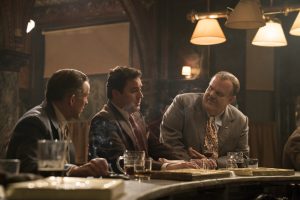
Working with British production company representative Bernard Delfont (Rufus Jones, center), the comedy duo of Stan Laurel (Steve Coogan, left) and Oliver Hardy (John C. Reilly, right) organize a series of stage shows to help promote a comic version of “Robin Hood” as seen in the entertaining new biopic, “Stan & Ollie.” Photo by Aimee Spinks, courtesy of Sony Pictures Classics.
To make up for this, Laurel and Hardy were asked to do a number of public promotional appearances to generate interest in the shows, a move that was believed would help garner more attention for the upcoming film. They were now working harder than ever. But, at least where the stage shows were concerned, these little stunts helped earn them sold-out dates at bigger and more prestigious venues, such as a two-week stint at London’s Lyceum. Things were at last looking better.
With success now coming their way, Stan and Ollie were joined in England by their wives, Ida (Nina Arianda) and Lucille (Shirley Henderson), respectively. They were experiencing what should have been the pinnacle of their careers, but such turned out not to be the case. Old resentments surfaced, Ollie’s health continued to worsen and shocking new surprises emerged, all of which conspired to potentially tear the duo apart.
But can an established, committed team like this one truly be split up by outside forces? That’s hard to do, even in the face of the most formidable circumstances, especially when those opposing forces are up against the strength of the bond uniting the partners. In a professional context like this, it might indeed sound strange to call the element that binds the collaborators what it genuinely is – love – but that’s what it is nevertheless. “Stan & Ollie” thus shows us what it means to employ this power in a forum other than romance. Whether or not we’re aware of it, it ultimately makes all kinds of tremendous creations possible. And, no matter what it’s used to produce, we should be forever grateful that we have it at our disposal for whatever creative purposes we choose to explore.

With their wives Lucille (Shirley Henderson, left) and Ida (Nina Arianda, right), respectively, the comedy duo of Oliver Hardy and Stan Laurel enjoy the good life while on a stage show tour of England and Ireland in “Stan & Ollie.” Photo by Nick Wall, courtesy of Sony Pictures Classics.
Of course, the power of love is driven by a belief in it, and beliefs are the cornerstone of the conscious creation process, the philosophy that maintains we manifest the reality we experience through them, as well as our thoughts and intents. In the case of Laurel and Hardy, they loved what they did, and this belief drove their success. It also formed the basis of their collaborative relationship, a force that became apparent in the results they produced, material that not only entertained their contemporaries, but that has lived on to this day. That’s quite a powerful force, and one that’s not easy to put down.
Laurel and Hardy also showed us the possibilities associated with reinvention. Even when their heyday was supposedly past, they managed to adapt and evolve. Their success may not have been immediate, but they learned how to make adjustments in their thinking – and the manifestations that came from it – to enjoy a renaissance of their own making. By pushing past supposed limitations, new outcomes are attainable, even when they retain elements of the past, including those that brought them their initial success. Their experience shows that all may not be lost, even when the chips appear down.
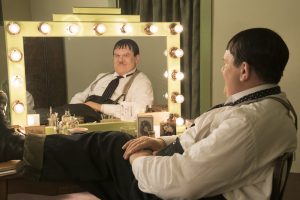
With his career fading and his health failing, comedian Oliver Hardy (John C. Reilly) does his best to carry on performing in the new biopic, “Stan & Ollie.” Photo by Aimee Spinks, courtesy of Sony Pictures Classics.
It’s comforting to know that we always have the power to shift gears and rejuvenate what we’ve thought we’ve lost. All we need do is believe in the possibility. Laurel and Hardy did, and we should be grateful that they had to the wisdom to do so.
While capably made, “Stan & Ollie” is nevertheless a somewhat “safe” and formulaic biopic that some might see as mediocre were it not for the positively outstanding performances of Reilly and Coogan, as well as several delightful supporting characters. The leads are so convincing that one might swear they’re channeling their historic characters. The period piece production values are also top notch across the board. However, in telling the story of this legendary duo, the film would have been more balanced had it included more about the pair’s rise to comedic greatness and not focused almost exclusively on their sunset years. All in all, this is a decent cinematic outing but one that probably could have (and should have) been better to do justice to the legacy of Laurel and Hardy.
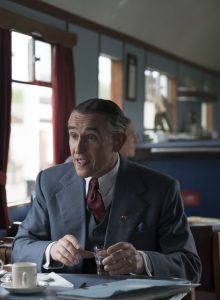
Comedian Stan Laurel (Steve Coogan) does his best to hold his comedy duo together in the face of difficult odds in “Stan & Ollie.” Photo by Aimee Spinks, courtesy of Sony Pictures Classics.
The film has fared well in awards competitions, earning three BAFTA nominations as Outstanding British Film, for Coogan’s lead performance, and for achievements in hair and makeup. The film also earned a Golden Globe nod for Reilly as best actor in a comedy.
Decades after their deaths, Laurel and Hardy still know how to make us laugh, as the re-creations of their routines show in this film. That illustrates the timelessness of their work, as well as the brilliance of those who created it. They truly loved their craft and the spirit of collaboration that they brought to it, an indomitable force that couldn’t be denied, even in the face of growing difficulties. Thank goodness they persevered so that their gift to the world can still be enjoyed to this day.
Copyright © 2019, by Brent Marchant. All rights reserved.
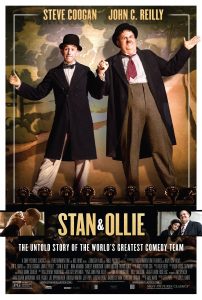




Leave A Comment